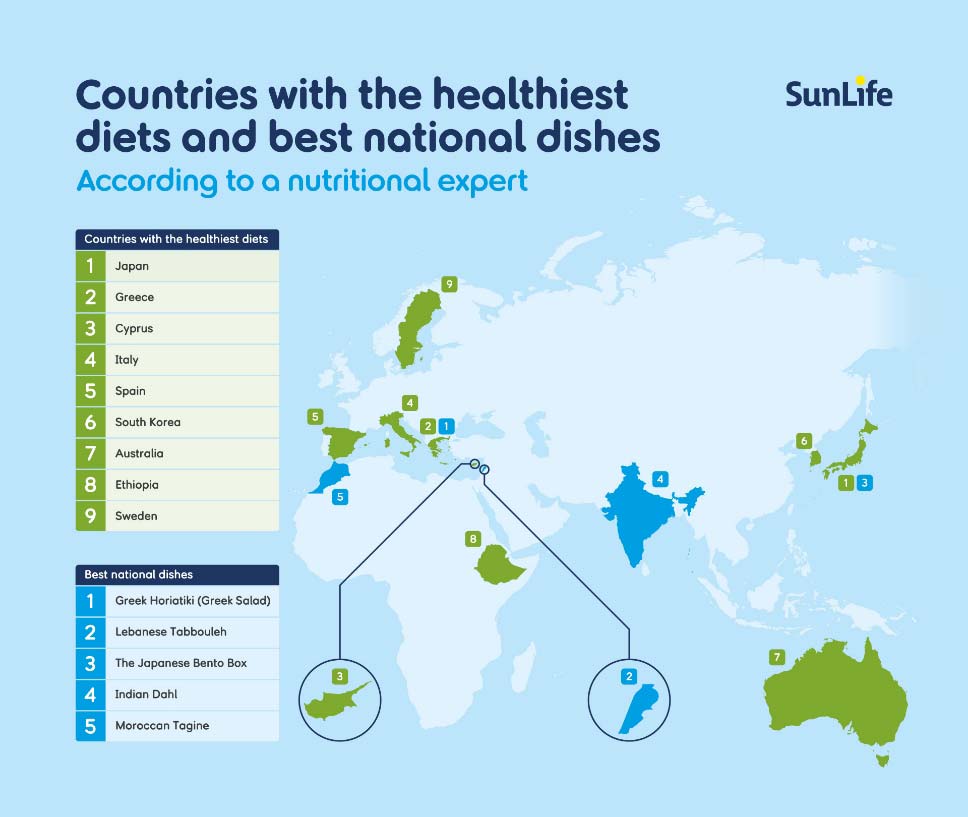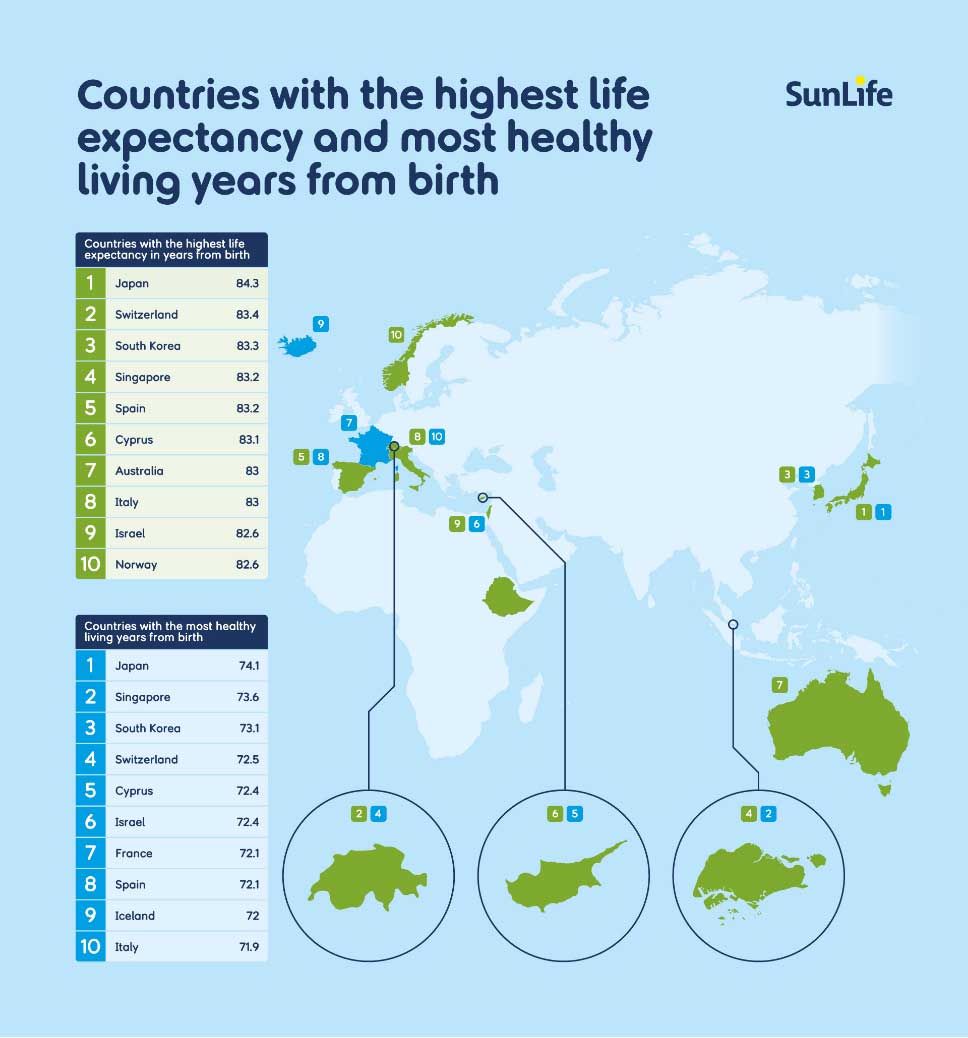What are the healthiest diets around the world?
Last updated 6th August 2024 by the SunLife Content Team
8 min read
We researched typical diets and national dishes from across the globe. Then we spoke to a nutritionist to get their expert insight on which may help you live longer in good health.
Living longer in good health is something that many of us aspire to. And it’s widely known that diet can play an important role in helping make this happen.
While everyone is unique and responds to food in different ways, we know that eating well is good for us. In fact, a balanced diet of fruits, vegetables, proteins, and carbohydrates can help us live longer.
With this in mind, we’ve explored the nation’s attitudes to healthy eating. We've also asked a nutritionist which countries they think have the healthiest diet. Let's take a look at what we can learn from eating habits around the world.

How Brits approach healthy eating and diet changes as we age
In our survey of 2,000 people, most Brits (81%) admitted they don’t get the recommended five portions of fruit and vegetables every day. But a third (32%) get this most days.
Those aged 55 to 64 are the most likely to say they only get their ‘five a day’ very rarely – less than five times a year (8%).
Nine in 10 adults (89%) also don’t eat the recommended amount of wholegrain carbohydrates (three portions a day).
Over three quarters (77%) aren’t getting the recommended amount of two portions of protein a day, such as meat, fish, eggs, beans, and pulses.
While many say they are aware of what a good diet looks like, around one in four Brits (23%) haven’t improved their diet as they’ve got older.
Men are less likely to have adapted their diet than women (26% versus 21%). And they’re also more likely to say they don’t ever plan to do this (14% versus 10% of women).
A worrying three in 10 (32%) 55 to 64-year-olds haven’t changed their diet at all as they’ve got older – the most of any age group polled.
This age group is also the most likely to say they won’t change their diet in any way as they head into their 70s and beyond (17%).
Interestingly, Brits aged 45 to 54 are the most likely to say they’ve changed their diet a lot (16%). Their main reasons for this included wanting to have more energy (50%) and losing weight (48%).
Out of all the people who've changed their diet as they’ve aged, over half (54%) did so to feel better and have more energy. And four in 10 (40%) said they wanted to feel better and lose weight.
One in three (33%) wanted to change their diet over concerns about the long-term impact their old diet was having on their health.
Those aged 55 to 64 who have changed their diet were most likely to have done it for this reason (42%).
Women were more likely to change their diet to increase their energy levels (58% versus 47% of men).
Men were more likely to change their diet because a friend, family member, or colleague had inspired them to do this (10% versus 4.5% of women). They were also more likely to make a change because their doctor told them to (25% versus 14% of women).
Healthy eating around the world, according to a nutritionist
According to the nutritionist we spoke to, the countries across the world with the best diets include:
- Japan
- Greece
- Cyprus
- Italy
- Spain
- South Korea
- Australia
- Ethiopia
- Sweden
Japan
Japan’s diet is characterised by fresh seafood, rice and vegetables. It also has fermented foods like miso. These can help you live longer, as they're full of nutrients and are minimally processed.
Another common food is Japan is tofu, which is an excellent source of plant-based protein. And green tea – a staple hot drink in Japan – is rich in antioxidants, so it can boost your metabolism and overall health.
The Mediterranean
The Mediterranean diet in countries like Greece, Cyprus, Italy, and Spain has lots of olive oil, fruits, vegetables, whole grains, and fish. These offer heart benefits and a balanced approach to fats and nutrients.
South Korea
South Korea's cuisine stands out for its fermented foods such as kimchi. It also includes lots of vegetables and lean protein from seafood – all of which are the backbone of a well-balanced, nourishing diet.
South Korea's emphasis on fermented foods means it’s known as the ‘fermentation hub’. These foods support a healthy microbiome, which is linked to improved digestion, immunity, and even mental health.
Australia
Australia’s diet is a unique mix of food cultures. It focuses on fresh, locally sourced produce, resulting in a varied and healthful diet.
Australians also have lots of fresh fruits and veg, lean protein from seafood and poultry, plus whole grains and legumes. These all provide essential nutrients.
Ethiopia
Ethiopian cuisine is vibrant and deeply traditional. It’s centred around plant-based ingredients and whole foods, which makes it stand out for health and nutrition.
Staple foods include injera, a nutrient-dense sourdough flatbread made from teff flour – plus legumes like lentils, chickpeas, and split peas. These provide essential proteins, fibre, and complex carbohydrates.
A variety of vegetables and the use of spices like berbere mean this diet is very nutritious. It offers vitamins, minerals, antioxidants, and anti-inflammatory properties. Plus, the inclusion of fermented foods further supports gut health.
Sweden
Sweden’s Nordic diet is full of whole grains like rye and barley, root vegetables, fatty fish such as salmon, and fermented dairy products like skyr. It prioritises simplicity and seasonal, local ingredients.
This diet can be heart-healthy and anti-inflammatory. It also supports overall wellbeing through its focus on unprocessed, nutrient-rich foods.

National dishes loved by a healthy eating expert
The nutritionist we spoke to said these are the national dishes they love – not just because they're healthy, but because they're delicious.
Greek horiatiki (Greek salad)
This vibrant salad is a staple of the Mediterranean diet, renowned for its nourishment. Horiatiki includes tomatoes, cucumbers, olives, red onion, and feta cheese. It’s topped off with a drizzle of olive oil.
This offers a potent mix of antioxidants, healthy fats, and fibre. The olives and olive oil are rich in monounsaturated fats, which are great for heart health – while the fresh vegetables provide essential vitamins and phytonutrients, which may help prevent cell damage.
Lebanese tabbouleh
Tabbouleh is a refreshing salad made primarily of parsley, bulghur wheat, tomatoes, mint, onion, and lemon juice. Parsley is packed with vitamins A, C, and K, and has lots of chlorophyll, which may help boost energy.
Bulghur, a whole grain, is an excellent source of fibre, which helps to keep your bowels regular. The fresh vegetables and herbs are full of nutrients, while the lemon juice offers a boost of vitamin C.
The Japanese bento box
The Japanese bento box is a balanced and nutritious meal served in a box with lots of different sections.
It typically includes steamed or vinegared rice, fish such as salmon or tuna, tofu, and a variety of steamed or pickled vegetables. Seaweed salad adds extra nutrition, while fresh fruits can give a sweet finish.
This meal reflects Japanese dietary principles of balance, variety, and moderation. It offers a satisfying combination of carbohydrates, protein, healthy fats, and essential nutrients. What’s more, it’s convenient and flavourful.
Indian dahl
Known to many as dal, daal, or dahl, this is a staple dish in Indian cuisine. It typically consists of lentils cooked with spices like turmeric, cumin, coriander, and sometimes ginger and garlic. It’s rich in protein, fibre, and complex carbohydrates, so it’s a filling and nutritious vegetarian option.
Different types of lentils such as moong dal, masoor dal, or chana dal provide varied textures. They’re also full of iron, folate, and potassium. The spices in dahl, like turmeric, have anti-inflammatory properties, while ginger and garlic aid digestion.
Typically served with rice or flatbreads, dahl provides a complete protein when paired with grains, making it a comforting and wholesome dish that supports a balanced diet.
Moroccan tagine
This traditional Moroccan stew is slow cooked in a clay pot. It combines meat such as chicken or lamb, vegetables like carrots, tomatoes, and potatoes, and dried fruits such as apricots or prunes – all seasoned with a blend of aromatic spices like cumin, paprika, cinnamon, and saffron.
The slow-cooking method allows the flavours to meld. It also preserves the nutrition of the ingredients. It’s full of vitamins, minerals, fibre, protein, and antioxidants.
Healthy living around the world, and life expectancy
Japan is the country that the most Brits (48%) named as having the healthiest diet in their opinion/based on what they know.
Other countries that Brits recognise as having very healthy diets include Italy (29%), Greece (23%), Spain (21%), and Sweden (12%).
Japan also has the highest average life expectancy (84.3 years) and the highest healthy living years (74.1).
South Korea, Singapore, Spain, Israel, Italy, Cyprus, and Switzerland also appear in the top 10 for both average life expectancy and most years lived in good health.
Countries with the highest life expectancy
| Life expectancy at birth (years) | |||
|---|---|---|---|
| Country | Both sexes | Male | Female |
| Japan | 84.3 | 81.5 | 86.9 |
| Switzerland | 83.4 | 81.8 | 85.1 |
| South Korea | 83.3 | 80.3 | 86.1 |
| Singapore | 83.2 | 81 | 85.5 |
| Spain | 83.2 | 80.7 | 85.7 |
| Cyprus | 83.1 | 81.1 | 85.1 |
| Australia | 83 | 81.3 | 84.8 |
| Italy | 83 | 80.9 | 84.9 |
| Israel | 82.6 | 80.8 | 84.4 |
| Norway | 82.6 | 81.1 | 84.1 |
Countries with the most healthy living years
| Healthy life expectancy (HALE) at birth (years) | |||
|---|---|---|---|
| Country | Both sexes | Male | Female |
| Japan | 74.1 | 72.6 | 75.5 |
| Singapore | 73.6 | 72.4 | 74.7 |
| South Korea | 73.1 | 71.3 | 74.7 |
| Switzerland | 72.5 | 72.2 | 72.8 |
| Cyprus | 72.4 | 71.8 | 73 |
| Israel | 72.4 | 72 | 72.7 |
| France | 72.1 | 71.1 | 73.1 |
| Spain | 72.1 | 71.3 | 72.9 |
| Iceland | 72 | 71.7 | 72.3 |
| Italy | 71.9 | 71.2 | 72.6 |

Blue zone diets to help people to live longer in good health
Our nutritional expert noted that countries with good diets are also often grouped under the term ‘blue zones’.
Blue zones are scattered around the globe. They’re home to people who consistently live well into their 90s.
The residents of these zones don’t rely on gimmicks, fad diets, or superfoods to stay healthy. They're simply living their lives with a few key principles in mind – one of which is eating mostly plants.
In these regions, people eat lots of whole foods like fruits, vegetables, legumes, and whole grains. Beans, lentils, and other legumes such as soy are also staples in their diet.
There's said to be no need for drastic calorie restriction or long periods of fasting. It's all about moderation and enjoying the pleasures of food.
While not strictly vegetarian, blue zone diets tend to have small portions of lean animal products, such as fish and poultry. And they’re not eaten too often.
Red meat is generally consumed sparingly, if at all. Food choices are often influenced by what's available locally and in season.
This means that people in blue zones get plenty of essential nutrients. And this supports their overall health by reducing the risk of chronic diseases such as heart disease, diabetes, and cancer.
Further reading
For more tips and tricks on diet changes as you age, take a look at our healthy eating guide for over 50s.
In addition to eating well and staying active as you get older, putting plans in place for your financial future can give you and your loved ones reassurance and peace of mind.
SunLife’s Guaranteed Over 50 Plan and Guaranteed Inheritance Plan are two life insurance options that may be suitable for you.
Nutritional expert
- Sandra Mikhail, author of The Gut Chronicles(www.hammersmithbooks.co.uk opens in a new tab)
Sources
- Survey of 2,000 UK adults (data split by respondent age, gender, and nearest city) – run between 17th and 27th June 2024
- Data on life expectancy(www.who.int opens in a new tab) and healthy living years(www.who.int opens in a new tab) per country pulled from World Health Organization
- Recommended portions of different food types taken from NHS Eatwell Guide(www.nhs.uk opens in a new tab)
The thoughts and opinions expressed in the page are those of the authors, intended to be informative, and do not necessarily reflect the official policy or position of SunLife. See our Terms of Use for more info.
